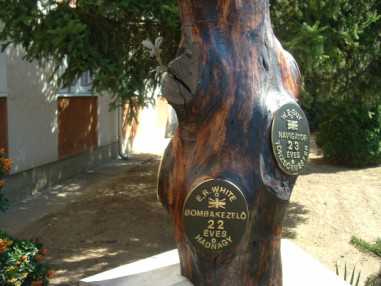The Symbol Of Ultimate Reconciliation
Szöveg: Ferenc Demeter | 2009. augusztus 29. 8:34The memorial erected in the village of Jászszentandrás to honour the memory of the crew of the British bomber that crashed in August 1944 was dedicated with all due ceremony. It was unveiled in the presence of diplomats of the concerned states by Minister of Defence Dr. Imre Szekeres and Mr Ferenc Banka, the mayor of the village.
Following the British, the South African, and the Hungarian national anthem and the greeting of the participants mayor Ferenc Banka delivered a speech. He emphasized that the memorial honouring the crew of the British airplane that had crashed near Jászszentandrás in World War II was erected on the initiative of the people living in the village. They want to honour the memory of those who had fallen in the war, and who had been forced into that senseless massacre. He thanked all those who had done something, even if it was the smallest thing, that enabled them to inaugurate the memorial in the courtyard of the school.

Mr Áron Dávid, a member of the local government briefly recalled the events that had taken place in 1944. He underlined that back then Hungary had become the scene of major military troop movements. “Traffic junctions, railway stations, airports, and bridges became primary targets. In addition to the aerial operations, the land operations also reached the Hungarian territories by that time. On 22 August 1944, hundreds of allied aircraft launched attacks against targets in Hungary and in the northeastern part of the country again. One of the airplanes from the 37th squadron of the 205th bomber group of the Royal Air Force took off at 20.01 from the military airport of Tortorella near Foggia, Italy. Flying over the Adriatic Sea and following the line of the Tisza river it was heading towards Miskolc. When it flew into Hungary it was hit and could continue flying for a while, but it blew up above Jászszentandrás. The fallen aircraft was a Wellington Mk X type medium bomber. It was the fourth sortie of the crew, namely 2nd Lieutenant White, Staff Sergeants Guy, Smith and Brown from Britain, and 1st Lieutenant Westlake from South Africa. The aircraft was probably shot by one of the German fighters that took off from Újvidék (Novi Sad). The soldiers who had been buried in the village cemetery were later exhumed and put to eternal rest in the British cemetery in Solymár" – he listed the events.
Minister Imre Szekeres said in his address that according to certain thinkers a war ends when the soldiers have returned home and when the relatives have buried their dead. “It can be added that a war ends ultimately when the opponents shake hands and discuss the lessons of the war. For us it makes no difference which side these soldiers were fighting on; they were executing a task when they were fatally hit. They were young, since even the oldest airman was only 23 years old, and they, too, had loved ones somewhere, who were waiting for them to return. These young people had hopes and ideas they could never realize. Their relatives can find comfort in the fact that the village where they had lost their lives did not receive them as enemies" – the minister said. The five young men were put to eternal rest first in the village cemetery, then in the cemetery of Solymár. From the beginning, the village regarded the soldiers as their own deceased. "Death makes no distinction, but we can change death by erecting a memorial for the heroes and bow our head before the deceased from time to time. Every generation has its task and there were some who had to take off in a bomber, searching for the target, and they executed horrible tasks. The mission of our generation is to end the war, to bury our dead for good, to remember, and reach out a hand to the other party, but in the meantime, we should also draw the necessary conclusions" – said Imre Szekeres.

Greg Dorey, the Ambassador of the United Kingdom emphasized in his address that he was very moved when he learned of the inauguration of the memorial. “The memorial should also be a warning, that such a terrible thing could never happen in Europe again. I saw a memorial in Budapest that commemorates the last governor of the 145-year Turkish rule. The inscription on the monument says that this is the place where the last Turkish ruler had fallen, who was a good fighter therefore may he rest in peace. This memorial is the symbol of true reconciliation. A similar intent to reconcile must have urged the people living here to erect this memorial, for which I thank them in the name of the governments of the countries involved and the relatives of the soldiers who had been killed in action, since these young men had also left families and friends behind, who where waiting for them to return. They had aims, wishes, and ambitions they could not realize. We have to act together, by now within the framework of an allied system, to preserve peace in Europe. This can be an atonement for these young soliders, proving that they did not die in vain" – he said.
Following the unveiling of the memorial, the attending senior officials of the local government, the military leaders, and the diplomats of the countries concerned laid wreaths on the new World War II memorial.
The ceremony ended with the tunes of the Szózat ("second national anthem") and Il Silenzio.